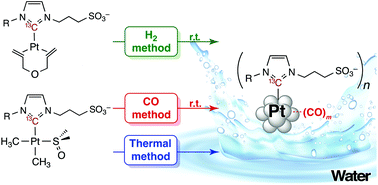当前位置:
X-MOL 学术
›
Dalton Trans.
›
论文详情
Our official English website, www.x-mol.net, welcomes your feedback! (Note: you will need to create a separate account there.)
Water-soluble platinum nanoparticles stabilized by sulfonated N-heterocyclic carbenes: influence of the synthetic approach†
Dalton Transactions ( IF 4 ) Pub Date : 2018-02-13 00:00:00 , DOI: 10.1039/c8dt00240a Edwin A. Baquero 1, 2, 3, 4, 5 , Simon Tricard 6, 7, 8, 9, 10 , Yannick Coppel 9, 10, 11, 12, 13 , Juan C. Flores 1, 2, 3, 4, 5 , Bruno Chaudret 6, 7, 8, 9, 10 , Ernesto de Jesús 1, 2, 3, 4, 5
Dalton Transactions ( IF 4 ) Pub Date : 2018-02-13 00:00:00 , DOI: 10.1039/c8dt00240a Edwin A. Baquero 1, 2, 3, 4, 5 , Simon Tricard 6, 7, 8, 9, 10 , Yannick Coppel 9, 10, 11, 12, 13 , Juan C. Flores 1, 2, 3, 4, 5 , Bruno Chaudret 6, 7, 8, 9, 10 , Ernesto de Jesús 1, 2, 3, 4, 5
Affiliation

|
The synthesis of metal nanoparticles (NPs) under controlled conditions in water remains a challenge in nanochemistry. Two different approaches to obtain platinum NPs, which involve the treatment of aqueous solutions of preformed sulfonated (NHC)Pt(II) dimethyl complexes with carbon monoxide, and of (NHC)Pt(0) diolefin complexes with dihydrogen (NHC = N-heterocyclic carbene), are disclosed here. The resulting NPs were found to be highly stable in water under air for an indefinite time period. Coordination of the NHC ligands to the platinum surface via the carbenic carbon was monitored by solid-state NMR spectroscopy, and the presence of a platinum–carbon bond was unambiguously evidenced by the determination of a 13C–195Pt coupling constant (1106 and 1050 Hz for NPs containing 13C labeled-NHC ligands and prepared under CO and H2, respectively). The coordination of CO to the (NHC)Pt(II) precursors prior to formation of the NPs was confirmed by NMR spectroscopy. When using a disulfonated NHC ligand, a second coordination sphere containing bis(NHC)Pt(II) complexes is described. Under CO, the formation of NPs was found to be slower than in a previously reported thermal method (Angew. Chem., Int. Ed., 2014, 53, 13220–13224), but led to NPs of similar sizes, whereas under H2, the synthesis of platinum NPs progressed even more slowly and produced larger NPs. In addition to the influence of the synthetic approach, the present study highlights the importance of ligand design for NP stabilization.
中文翻译:

磺化N-杂环卡宾稳定的水溶性铂纳米颗粒:合成方法的影响†
在受控条件下在水中合成金属纳米颗粒(NPs)仍然是纳米化学中的一个挑战。获得铂NP的两种不同方法,包括用一氧化碳处理预先形成的磺化(NHC)Pt(II)二甲基配合物和具有二氢的(NHC)Pt(0)二烯烃配合物(NHC = N-杂环)的水溶液卡宾),在此公开。发现所得的NP在空气中在不确定的时间内在水中高度稳定。通过固态NMR光谱法监测NHC配体通过羧碳与铂表面的配位,并通过测定13 C– 195明确证明了铂-碳键的存在。Pt耦合常数(对于含有13个C标记的-NHC配体的NP ,分别在CO和H 2下制备,分别为1106和1050 Hz )。通过NMR光谱证实了在NP形成之前CO与(NHC)Pt(II)前体的配位。当使用二磺化的NHC配体时,将描述包含双(NHC)Pt(II)配合物的第二配位球。下CO,NP的形成被认为是比在先前报道的热法(较慢Angew化学杂志,诠释。编,2014,53,13220-13224),但是导致了类似大小的纳米颗粒,而在H 2个,铂纳米颗粒的合成进展甚至更加缓慢,并产生了更大的纳米颗粒。除了合成方法的影响外,本研究还强调了配体设计对NP稳定的重要性。
更新日期:2018-02-13
中文翻译:

磺化N-杂环卡宾稳定的水溶性铂纳米颗粒:合成方法的影响†
在受控条件下在水中合成金属纳米颗粒(NPs)仍然是纳米化学中的一个挑战。获得铂NP的两种不同方法,包括用一氧化碳处理预先形成的磺化(NHC)Pt(II)二甲基配合物和具有二氢的(NHC)Pt(0)二烯烃配合物(NHC = N-杂环)的水溶液卡宾),在此公开。发现所得的NP在空气中在不确定的时间内在水中高度稳定。通过固态NMR光谱法监测NHC配体通过羧碳与铂表面的配位,并通过测定13 C– 195明确证明了铂-碳键的存在。Pt耦合常数(对于含有13个C标记的-NHC配体的NP ,分别在CO和H 2下制备,分别为1106和1050 Hz )。通过NMR光谱证实了在NP形成之前CO与(NHC)Pt(II)前体的配位。当使用二磺化的NHC配体时,将描述包含双(NHC)Pt(II)配合物的第二配位球。下CO,NP的形成被认为是比在先前报道的热法(较慢Angew化学杂志,诠释。编,2014,53,13220-13224),但是导致了类似大小的纳米颗粒,而在H 2个,铂纳米颗粒的合成进展甚至更加缓慢,并产生了更大的纳米颗粒。除了合成方法的影响外,本研究还强调了配体设计对NP稳定的重要性。



























 京公网安备 11010802027423号
京公网安备 11010802027423号